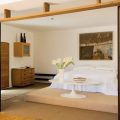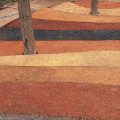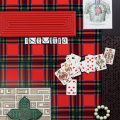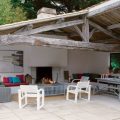Stylist: Maria Vatolina.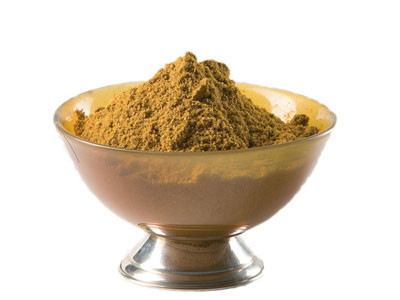 Oriental style room
Oriental style room
 Using hints is for poor students.We are ready to argue with this statement. Example. To design an interior in an ethnic key, you can spend a long time tediously studying albums on the history of art or dig even deeper - try to delve into the color theories of Newton and Goethe and break down at the phrase "the approaches of Newton and Goethe are opposite to each other, like analysis and synthesis." And understand that - you will not understand anything. This thorny path is unlikely to lead you to the result. It is much simpler and more reasonable to find a ready-made palette. Find and repeat. So, here is a hint: any ethnic interior can be built using as a basis the colors of spices used in national cuisine. This frivolous, at first glance, statement has a completely scientific basis. Research has shown that the colors in the traditional interior and costume of any country are directly related to the surrounding nature, the product of which are natural dyes and spices (this range is called "earth colors"). When selecting objects and finishing materials by color, one rule should be remembered: the main palette should be "diluted" with opposite colors of the spectrum (as shown in the color chart). This is done so that the eye does not get tired of monotony. For example, yellow, ginger, brown and red in an oriental interior are traditionally complemented by turquoise, purple, olive green.
Using hints is for poor students.We are ready to argue with this statement. Example. To design an interior in an ethnic key, you can spend a long time tediously studying albums on the history of art or dig even deeper - try to delve into the color theories of Newton and Goethe and break down at the phrase "the approaches of Newton and Goethe are opposite to each other, like analysis and synthesis." And understand that - you will not understand anything. This thorny path is unlikely to lead you to the result. It is much simpler and more reasonable to find a ready-made palette. Find and repeat. So, here is a hint: any ethnic interior can be built using as a basis the colors of spices used in national cuisine. This frivolous, at first glance, statement has a completely scientific basis. Research has shown that the colors in the traditional interior and costume of any country are directly related to the surrounding nature, the product of which are natural dyes and spices (this range is called "earth colors"). When selecting objects and finishing materials by color, one rule should be remembered: the main palette should be "diluted" with opposite colors of the spectrum (as shown in the color chart). This is done so that the eye does not get tired of monotony. For example, yellow, ginger, brown and red in an oriental interior are traditionally complemented by turquoise, purple, olive green. Color scheme (from left to right):Sugar Bag Light, matt emulsion, Farrow & Ball. Volcanic Splash 2, matt emulsion, Dulux. Velvet Plum, silk effect emulsion, Crown. Tarragon Glory 3, glossy emulsion, Dulux. Jamaican Ginger 3, matt emulsion, Dulux.
Color scheme (from left to right):Sugar Bag Light, matt emulsion, Farrow & Ball. Volcanic Splash 2, matt emulsion, Dulux. Velvet Plum, silk effect emulsion, Crown. Tarragon Glory 3, glossy emulsion, Dulux. Jamaican Ginger 3, matt emulsion, Dulux. To avoid «conflicts»Opposite colors are used only as small inclusions. The ideal ratio is considered to be 70:20:10, where 70% is the dominant color (the walls and floor can be painted with it), 20% is the second color, and 10% are accents placed by the third. These colors can be used both in pure form (monochrome painting) and mixed (ornamental patterns). The materials can be authentic (zelish tiles, kilim, etc.) or their modern version. For example, our stylist used photo wallpaper with prints of Moroccan tiles by British designer Dominic Crinson as a background. The national flavor did not suffer at all from this and even benefited. P.S. There is one undeniable advantage in decorating an interior based on spices. No one will dare to reproach you for lack of taste. And if someone tries to do this, you can always answer: "My interior tastes like paprika, curry, cinnamon, marjoram, saffron and cloves." The actual color of the paints may differ from the samples presented in the article.
To avoid «conflicts»Opposite colors are used only as small inclusions. The ideal ratio is considered to be 70:20:10, where 70% is the dominant color (the walls and floor can be painted with it), 20% is the second color, and 10% are accents placed by the third. These colors can be used both in pure form (monochrome painting) and mixed (ornamental patterns). The materials can be authentic (zelish tiles, kilim, etc.) or their modern version. For example, our stylist used photo wallpaper with prints of Moroccan tiles by British designer Dominic Crinson as a background. The national flavor did not suffer at all from this and even benefited. P.S. There is one undeniable advantage in decorating an interior based on spices. No one will dare to reproach you for lack of taste. And if someone tries to do this, you can always answer: "My interior tastes like paprika, curry, cinnamon, marjoram, saffron and cloves." The actual color of the paints may differ from the samples presented in the article.

Making Money with Desserts: Success Stories
Evgeniya Polischuk (Fedutinova) instagram:@evgeniyafedutinovavk.com/janeshomebaking– It all started with baking for family and friends. Gradually, I started posting photos of my baked goods on Instagram – and orders started coming in. I made my first custom-made cake on October 13, 2014, and a little earlier I started making macaroons and cupcakes. You could say that the business “found me”, I am very […]

Soups are cold recipes with photos
Cold cucumber soup with yogurt and lemonsorbet from the chef of the restaurant La Taverna Alexander Zhurkin Photo: Getty Images Ingredients: Plain yoghurt – 125 g Cucumber – 150 g Lemon/lime sorbet – 50 g Cocktail shrimp – 24 g Fresh ginger juice – 1 g Lime juice – 5 g Fresh orange juice – 5 g Parsley – 1 g Pink pepper – 1 g Watercress – […]

barbeque kebab
Pork tenderloin in glaze Photo:Dmitry Bayrak/dbstudioPreparation time: 20 minutes + marinating time.Calories: 454 kcal per serving.For 4 servings: 4 pork tenderloins (approximately 300 g each), 1 onion, 2 cloves of garlic, 1 tsp. lemon zest, 1 tsp. lemon juice, a pinch of ground cumin, coriander and turmeric, 1 tbsp. vegetable […]

Pierre Duacan: dietary recipes: Ducane diet
Beetroot soup Photo:Season’S, Luxury Hotels RepresentationYou will need:· Boiled beetroot – 60 g· Fresh cucumbers – 20 g· Red radish – 20 g· Green onions – 10 g· Egg – 1 pc.· Drinking mineral water – 200 g· Salt – 1 gPreparation:· Boil the egg and beetroot.· Grate the cucumbers, radish and part of the beetroot. Put everything […]

